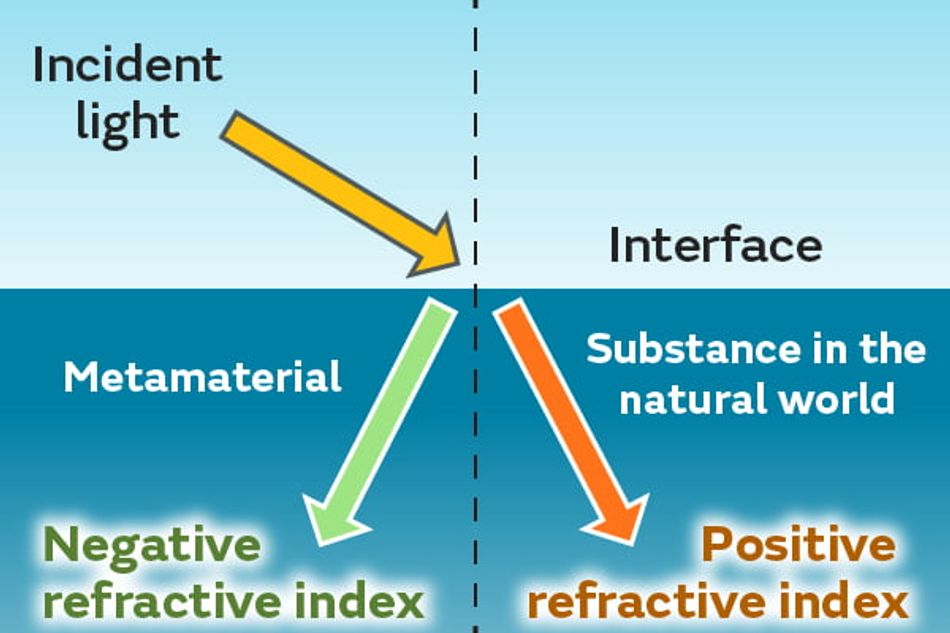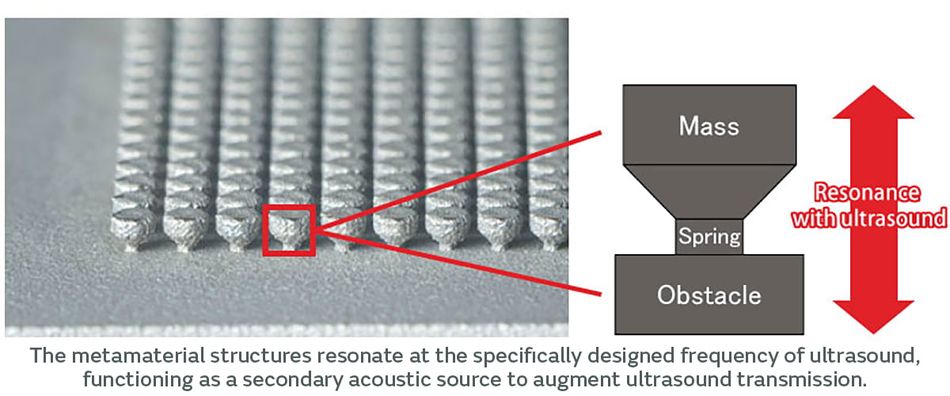What Are Metamaterials That Expand Possibilities with Behavior Not Found in Substances in the Natural World?
Metamaterials are artificial substances that allow wave phenomena such as light and other electromagnetic waves and sound (sound waves) to be controlled as desired by behaving in ways not found in substances in the natural world. "Meta" is a Greek word that means "transcending."
This article was first published on
article.murata.comWhat Are Metamaterials: Composition, Mechanisms, Features, and More
Metamaterials are artificial substances that allow wave phenomena such as light and other electromagnetic waves and sound (sound waves) to be controlled as desired by behaving in ways not found in substances in the natural world. "Meta" is a Greek word that means "transcending."
We explain below the composition and mechanism of metamaterials, their major feature of a negative refractive index, the differences with metasurfaces, and more.
Composition and Mechanism of Metamaterials
In general, metamaterials are composed of microscopic structures arranged in large quantities. Each structure is called a "meta atom," "meta-atom," or similar.
For instance, the feature of the meta-atoms that comprise a metamaterial used to control electromagnetic waves of a specific wavelength is that they are sufficiently smaller than the wavelength of the electromagnetic waves you want to control.
Designing the shape, size, arrangement spacing, and other elements of the meta-atoms that comprise the metamaterial enables behavior different from substances in the natural world like the negative refractive index we will introduce next.
Features of Metamaterials: What Is a Negative Refractive Index?
The leading feature of metamaterials is something called a "negative refractive index."
For example, as shown in Fig. 1, the path of light bends in a positive direction relative to the direction of incidence due to refraction at the interface between the air and the water. This phenomenon in the natural world is called a "positive refractive index."
On the other hand, if this light is incident on a metamaterial with a structure smaller than the wavelength of the light, it is possible to give it a refractive index in the negative direction like drawing a "<" symbol. In this way, metamaterials can behave differently from substances in the natural world. It is possible to control the reflection, transmission, and other properties of specific wavelengths such as electromagnetic waves (light and radio waves) and sound waves.
Differences between Metamaterials and Metasurfaces
One type of metamaterial is an artificial substance called a metasurface. The difference between the two is that metasurfaces have a two-dimensional structure on their surface in contrast to metamaterials, which have a microscopic three-dimensional structure. There are metasurfaces and other substances whose purpose is to control the reflection characteristics of electromagnetic waves (radio waves). It is expected that these substances will be applied to applications such as next-generation mobile communication systems.
Types, Usage Examples, and Prospects of Metamaterials
If we include those in the research and design stage in addition to those already being put into practical use, there are a wide variety of metamaterials. The following are given as the leading types of metamaterials.
- Electromagnetic metamaterials
- Thermal metamaterials
- Acoustic metamaterials
We give an overview of each of these metamaterials below together with a description of their usage examples, prospects, and more.
Overview, Usage Examples, and Prospects of Electromagnetic Metamaterials
It is possible to control the specific wavelength of electromagnetic waves (light and radio waves) by applying the negative refractive index we mentioned earlier. For instance, humans see the appearance of objects with the light reflected from them. However, applying and controlling the negative refractive index with electromagnetic metamaterials, it is possible to change the way the object looks. Therefore, it is expected this will be applied in the optics field in addition to the field of wireless communications.
Usage Examples and Prospects of Electromagnetic Metamaterials
It is said that the limit of the size that can be seen with an optical lens is approximately 200 nm. Nevertheless, it is thought to be theoretically possible to make super lenses (perfect lenses) that allow users to see even smaller objects and flat lens with no unevenness by applying electromagnetic metamaterials. Moreover, it is also believed to be possible to create optical camouflage (an invisibility cloak) if we divert the background scenery (light) to the front by controlling the refractive index of light.
Meanwhile, it is expected that electromagnetic metamaterials will be used to reflect and receive specific wavelengths in communication radio waves such as the terahertz waves (and sub-terahertz waves) being considered for introduction in the 6th generation mobile communication system (6G) among electromagnetic waves.
Overview, Usage Examples, and Prospects of Thermal Metamaterials
Thermal metamaterials are used to control the transmission of heat. They are mainly used in applications such as temperature adjustment inside devices and similar through heat dissipation by emitting infrared wavelengths.
Usage Examples and Prospects of Thermal Metamaterials
Electronic devices and the electronic components inside them are susceptible to damage by intense heat. It is possible to achieve both heat dissipation and downsizing by using thermal metamaterials as an infrared emission sheet to ensure heat dissipation even when the inside of the housing is narrow.
Moreover, thermal metamaterials can also be used to reflect light and suppress the rise in temperature in devices used in outdoor environments. Research is underway to protect electronic devices from dramatic temperature differences by controlling the reflection or absorption of sunlight in transport aircraft, artificial satellites, probes, and other devices used even in the harsh space environment outside the Earth's atmosphere.
Furthermore, research is also being conducted on the efficient reuse of thermal energy, which was previously just emitted from vehicles, machines, and equipment by artificially generating a temperature difference with localized heat generation using a metamaterial that absorbs infrared rays and utilizing it as a thermoelectric conversion material to convert thermal energy into electricity.
Overview, Use, and Prospects of Acoustic Metamaterials
Acoustic metamaterials control the absorption and reflection of ultrasonic waves and other sound waves and vibrations. They are widely used for purposes such as soundproofing, sound insulation, and vibration control. Moreover, they have various applications such as to improve permeability under conditions in which ultrasonic waves and other sound waves are normally blocked.
Usage Examples and Prospects of Acoustic Metamaterials
Acoustic metamaterials are attracting attention for their wide range of uses as a material to control the absorption and reflection of sound. These uses include noise suppression in factories and construction sites, sound-absorbing panels that reduce sound leakage in office business discussion spaces, meeting rooms, and similar, and vibration suppression in floors, which is an issue in apartment buildings. In addition, it is also expected that acoustic metamaterials will be used as lightweight and effective soundproofing materials in the field of automobiles.
Furthermore, it is expected that acoustic metamaterials that control the transmission of ultrasonic waves will be used in a wide range of fields such as in methods of installing and operating ultrasonic sensors that was previously difficult and in improving the degree of freedom in ultrasound examinations in medical care.
We introduce and explain below about the Ultrasound Transmission Metamaterial, an acoustic metamaterial, developed by Murata Manufacturing.
Murata Manufacturing's Acoustic Metamaterial: Ultrasound Transmission Metamaterial

Murata Manufacturing is developing the Ultrasound Transmission Metamaterial. This is an acoustic metamaterial that increases the permeability of ultrasonic waves with respect to substances by employing a resonance mechanism that uses a spring pendulum structure.
As shown in Fig. 2, miniscule unit cells comprising a weight and spring are arranged periodically on a sheet in the spring pendulum structure. Adjusting the shape and size of the weights and springs allows these unit cells to play the role of a spring pendulum that moves with the incidence of ultrasonic waves. As a result, it resonates in a direction perpendicular to the incident ultrasonic waves and passes through obstacles with a large difference in acoustic impedance*1 to improve the ultrasonic transmission efficiency.
*1: The acoustic impedance indicates with a numerical value the ease of sound transmission. It can be calculated with the formula "density of the medium × speed of sound in the medium." Each object has its own unique impedance. Ultrasonic waves are characterized by being reflected when the difference in acoustic impedance is large and being transmitted when it is small.
If we apply the properties that improve the permeability of ultrasonic waves in ultrasound transmission metamaterial substances, in the medical field, for instance, it becomes possible to perform ultrasound scans that previously could not be used to examine brains because ultrasonic waves do not normally transmit through the skull. If we perform ultrasound scans, there are no concerns of radiation exposure unlike with X-rays, MRIs, CT scans, and other X-ray examinations.
Moreover, using ultrasound transmission metamaterials in the panels of automobiles to improve the permeability of ultrasonic waves makes it possible to build ultrasonic sensors into automobiles without comprising the appearance of the body. Thus, it is anticipated that this will have a variety of usages. Please also check out the developer interview we have below.
Developer interview:
“Ultrasound Transmission Metamaterial” that Expands the Range of Places where Ultrasonic Sensors Can Be Used to Include Medicine and Automobiles
*The details of the Ultrasound Transmission Metamaterial in this article are information as of the time and date of its publication. The specifications and appearance of the products introduced in this article are subject to change without notice.




